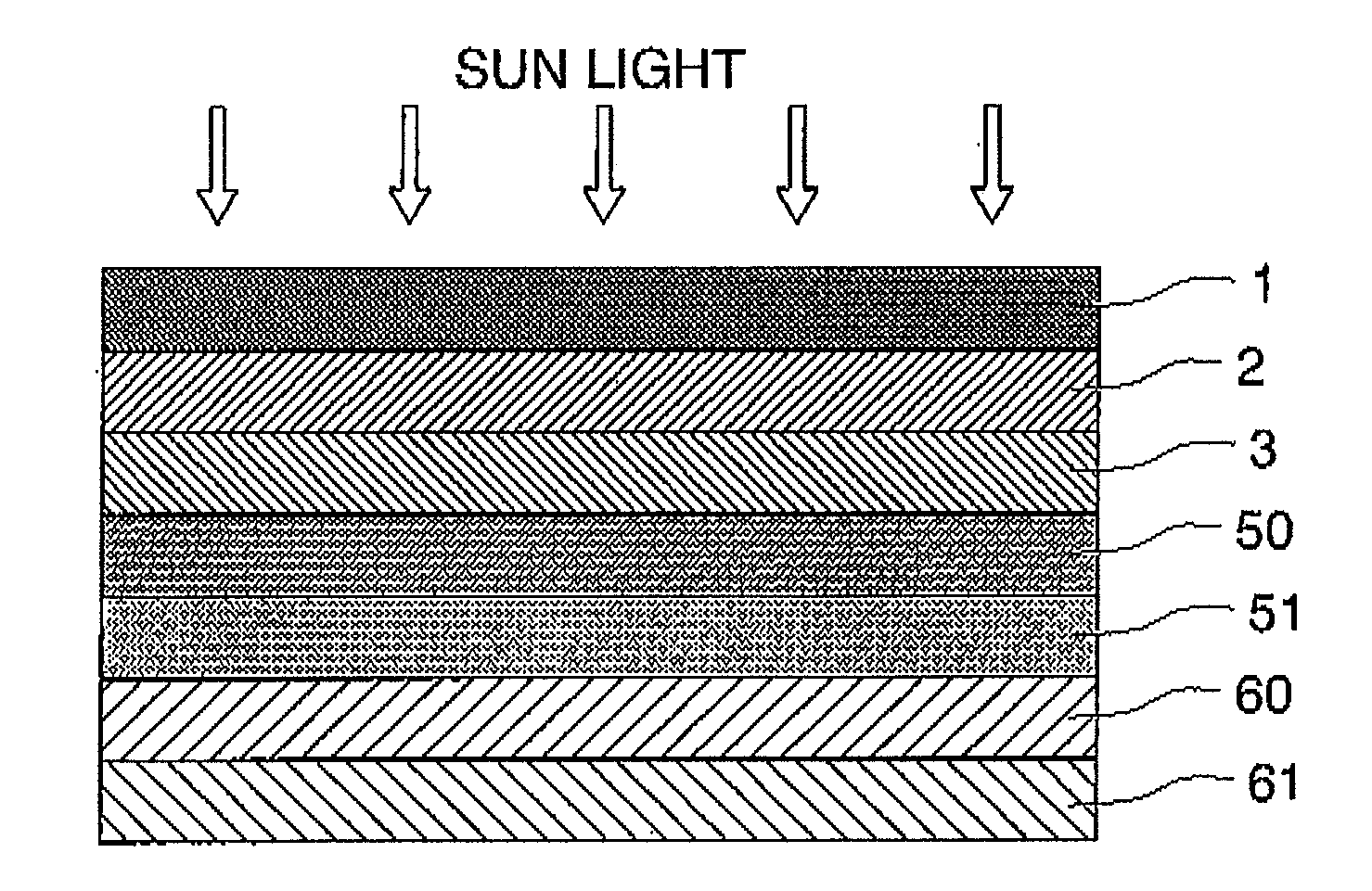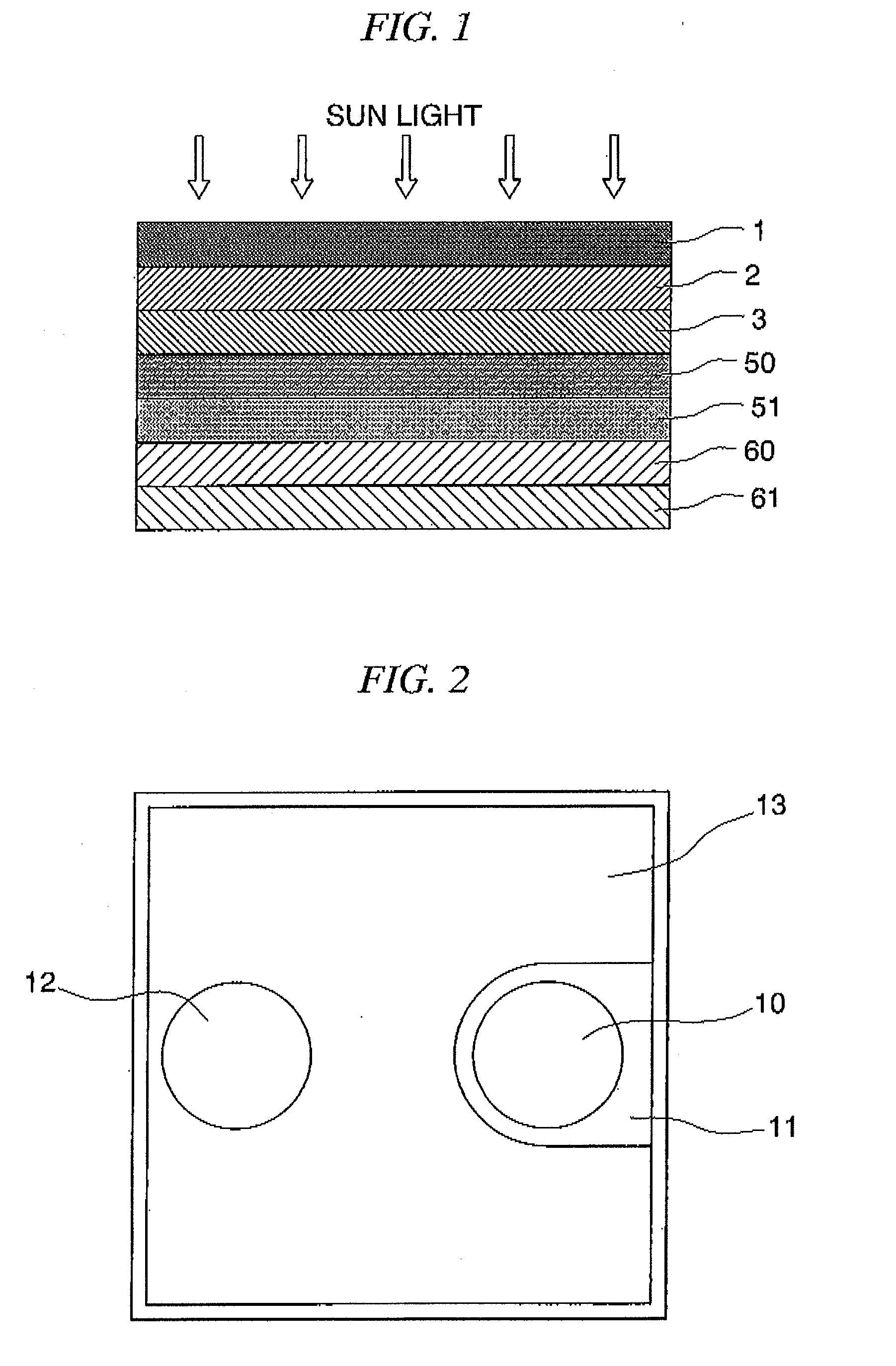Solar cell and method for producing the same
- Summary
- Abstract
- Description
- Claims
- Application Information
AI Technical Summary
Benefits of technology
Problems solved by technology
Method used
Image
Examples
example 1
[0198]In Example 1, the solar cell including the laminate shown in FIG. 1 was produced.
[0199]First of all, the AlN buffer layer 2 having a thickness of 30 nm, and the undoped GaN base layer 3 having a thickness of 0.1 μm were layered on the quartz glass substrate 1. The used quartz glass is a commercially available optical material, and has a square size of 30 cm.
[0200]Specifically, the AlN buffer layer 2 was layered on the substrate 1 by hitting an Al target with argon plasma to beat out Al atoms, and making the Al atoms react with nitrogen, while introducing a mixed gas containing argon and nitrogen into a chamber and using nitrogen plasmas, which were obtained by applying an electrical field.
[0201]In a similar way to the AlN buffer layer 2, the undoped GaN base layer 3 was layered on the AlN buffer layer 2 by hitting a Ga target with argon plasmas to beat out Ga atoms, and making the Ga atoms react with nitrogen, while introducing a mixed gas containing argon and nitrogen into th...
example 2
[0216]The laminate shown in FIG. 1 was produced by a method which is different from the method in Example 1.
[0217]The AlN buffer layer 2 having a thickness of 30 nm was formed on the quartz substrate 1 by the RF magnetron sputtering method. Then, the substrate was removed from the sputtering device, and subjected a thermal treatment in an annealing furnace at 1,100° C. for 10 minutes under nitrogen atmosphere. After that, the substrate was introduced into the MOCVD furnace, and the p-type GaN layer 51, which was doped with Mg, was formed so as to prepare the laminate obtained in Example 1.
[0218]During the MOCVD method, common temperature, pressure, gas used, etc., were adopted.
[0219]The carrier concentration of the n-type GaN layer 50 and the p-type GaN layer 51 was about 2×1018 atoms / cm3.
[0220]Then, the solar cell element was obtained using the obtained laminate, in a similar way to Example 1. The obtained solar cell element was divided into squares in 1 cm×1 cm. The electrodes wer...
example 3
[0221]In Example 3, the solar cell including the laminate shown in FIG. 3 was produced.
[0222]First of all, an AlN buffer layer 2 having a thickness of 30 nm was formed on the quartz substrate 1 by the RF magnetron sputtering method. Then, the substrate was removed from the sputtering device, and subjected a thermal treatment in an annealing furnace at 1,100° C. for 10 minutes under nitrogen atmosphere. After that, the substrate was introduced into the MOCVD furnace. Then, the laminate, which includes the undoped GaN layer 3 having thickness of 6 μm, the n-type Inx1Ga1-x1N layer 70 (X1=0.09) having a thickness of 0.1 nm, and the p-type Inx1Ga1-x1N layer 71 (X1=0.09) having a thickness of 0.2 μm, was formed on the AlN buffer layer 2.
[0223]The carrier concentration of the n-type Inx1Ga1-x1N layer 70 and the p-type Inx1Ga1-x1N layer 71 was about 3×1018 atoms / cm3.
[0224]Then, the solar cell element was obtained using the obtained laminate, in a similar way to Example 1. The obtained solar...
PUM
 Login to View More
Login to View More Abstract
Description
Claims
Application Information
 Login to View More
Login to View More - R&D
- Intellectual Property
- Life Sciences
- Materials
- Tech Scout
- Unparalleled Data Quality
- Higher Quality Content
- 60% Fewer Hallucinations
Browse by: Latest US Patents, China's latest patents, Technical Efficacy Thesaurus, Application Domain, Technology Topic, Popular Technical Reports.
© 2025 PatSnap. All rights reserved.Legal|Privacy policy|Modern Slavery Act Transparency Statement|Sitemap|About US| Contact US: help@patsnap.com



